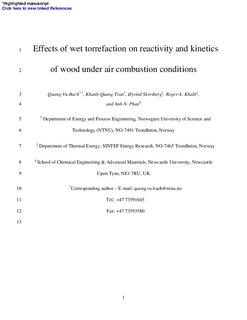| dc.contributor.author | Bach, Quang Vu | |
| dc.contributor.author | Tran, Khanh-Quang | |
| dc.contributor.author | Skreiberg, Øyvind | |
| dc.contributor.author | Khalil, Roger Antoine | |
| dc.contributor.author | Phan, N. Anh | |
| dc.date.accessioned | 2017-12-07T07:28:10Z | |
| dc.date.available | 2017-12-07T07:28:10Z | |
| dc.date.created | 2014-08-05T18:28:39Z | |
| dc.date.issued | 2014 | |
| dc.identifier.citation | Fuel. 2014, 137 375-383. | nb_NO |
| dc.identifier.issn | 0016-2361 | |
| dc.identifier.uri | http://hdl.handle.net/11250/2469458 | |
| dc.description.abstract | This work continues our assessment of wet torrefaction for energy applications, looking at effects of the process parameters (temperature, holding time and pressure) on the reactivity and intrinsic kinetics of wood under air combustion conditions. Woody materials, Norway spruce and birch, were wet torrefied in various conditions (temperature: 175, 200, 225 °C; holding time: 10, 30, 60 min; and pressure: 15.54, 70, 160 bar). The reactivity of the treated and untreated woods was thermogravimetrically examined under a synthetic air environment (21% O2 and 79% N2 in volume). A four-pseudo-component model with different reaction orders was adopted for kinetic modelling and extracting the kinetic parameters. The results showed that when increasing either torrefaction temperature or holding time, the torrefied woods behaved more char-like than the raw fuels. However, pressure did not show significant effect on the reactivity. Relatively longer char combustion stages and higher conversion rates (up to 0.5 × 10−3 s−1) were observed for the woods after torrefaction. The activation energy was decreased for hemicellulose and char, but increased for cellulose after torrefaction, whereas the trend for lignin is not clear. In addition, the hemicellulose mass fraction decreased after torrefaction (from 0.15 to 0.05 for spruce and from 0.23 to 0.06 for birch). The amount of char in the torrefied woods increased gradually with increasing torrefaction temperature or holding time (from 0.24 to 0.40 for spruce, and from 0.18 to 0.34 for birch). Copyright © 2014 Published by Elsevier Ltd. | nb_NO |
| dc.language.iso | eng | nb_NO |
| dc.publisher | Elsevier | nb_NO |
| dc.relation.uri | http://dx.doi.org/10.1016/j.fuel.2014.08.011 | |
| dc.rights | Attribution-NonCommercial-NoDerivatives 4.0 Internasjonal | * |
| dc.rights.uri | http://creativecommons.org/licenses/by-nc-nd/4.0/deed.no | * |
| dc.title | Effects of wet torrefaction on reactivity and kinetics of wood under air combustion conditions | nb_NO |
| dc.type | Journal article | nb_NO |
| dc.type | Peer reviewed | nb_NO |
| dc.description.version | acceptedVersion | nb_NO |
| dc.source.pagenumber | 375-383 | nb_NO |
| dc.source.volume | 137 | nb_NO |
| dc.source.journal | Fuel | nb_NO |
| dc.identifier.doi | 10.1016/j.fuel.2014.08.011 | |
| dc.identifier.cristin | 1145442 | |
| dc.relation.project | Norges forskningsråd: 199897 | nb_NO |
| dc.relation.project | Norges forskningsråd: 193817 | nb_NO |
| dc.description.localcode | © 2014. This is the authors’ accepted and refereed manuscript to the article. This manuscript version is made available under the CC-BY-NC-ND 4.0 license http://creativecommons.org/licenses/by-nc-nd/4.0/ | nb_NO |
| cristin.unitcode | 194,64,25,0 | |
| cristin.unitname | Institutt for energi- og prosessteknikk | |
| cristin.ispublished | true | |
| cristin.fulltext | postprint | |
| cristin.qualitycode | 2 | |

